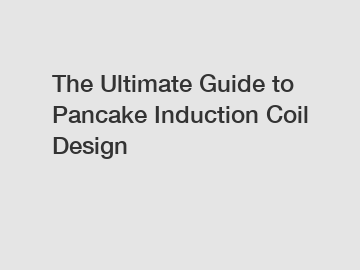The Ultimate Guide to Pancake Induction Coil Design
The Ultimate Guide to Pancake Induction Coil Design.
Induction heating is a widely used technology in various industries, from metal processing to cooking. At the heart of induction heating systems is the induction coil, which generates an alternating magnetic field to induce currents in a conductive material. Within the realm of induction heating, pancake induction coils offer unique advantages. In this article, we will provide an ultimate guide to pancake induction coil design, discussing its benefits, factors to consider during design, and important design tips.
Benefits of Pancake Induction Coils.

Pancake induction coils are known for their flat, circular shape, making them suitable for heating flat or cylindrical objects. Their design allows for efficient and uniform heating, as the magnetic field is evenly distributed over the entire width of the coil. This characteristic makes pancake induction coils ideal for applications where consistent heating is required, such as in cooking utensils or surface hardening of gears.
Factors to Consider in Pancake Induction Coil Design.
1. Size and Shape: The size and shape of the pancake coil should be tailored to the part being heated. It is essential to consider the dimensions and geometry of the object to ensure optimal heat penetration and coverage.
2. Material and Thickness: The material and thickness of the pancake coil determine its electrical conductivity and impedance. Copper is commonly used due to its excellent electrical conductivity, but other materials like aluminum can be used for specific applications. The thickness of the coil affects its mechanical strength and heat dissipation capabilities.
3. Number of Turns: The number of turns in the coil affects the magnetic field strength and the amount of power transferred to the part being heated. More turns result in a stronger magnetic field but also increase the coil's inductance, requiring adjustments in the power supply.
Design Tips for Pancake Induction Coils.
1. Use High-Quality Materials: To ensure the longevity and efficiency of the pancake coil, high-quality materials should be used. This includes using properly insulated copper wire and utilizing a suitable coil former material that can withstand the high temperatures generated during operation.
2. Consider Cooling Options: Pancake coils generate heat during operation, and adequate cooling mechanisms should be incorporated into the design. This can involve using cooling water channels or considering forced air cooling to prevent overheating and maintain performance.
3. Optimize Coil Shape: The shape of the pancake coil can be optimized to suit specific applications. For instance, adding notches or grooves to the outer edge of the coil can improve the magnetic field concentration in certain areas, allowing for localized heating.
Conclusion.
Designing a pancake induction coil requires careful consideration of various factors such as size, shape, materials, and cooling mechanisms. By understanding these elements and implementing good design practices, one can optimize the performance and efficiency of the coil for specific applications. Pancake induction coils offer great versatility and consistency in induction heating processes. If you need further guidance or assistance in pancake induction coil design, please feel free to contact us.
[Contact Us].
If you want to learn more, please visit our website induction heating machine for forging, induction brazing equipment, industrial induction heating.

Comments
0